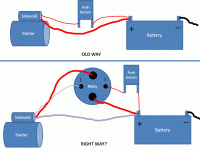CMV
Platinum Member
83 JD 500C backhoe.
Electrical is 100 different kinds of screwed up on the machine. I had the starter relay (or solenoid relay or starter solenoid - I see it called several things but I"m not talking about the solenoid that's parked on top of the starter but the solenoid/relay before the starter & it's solenoid) bypassed. Small wire from start switch to solenoid (that's affixed to starter), main battery +12V direct to same solenoid. Worked for a while & now has finally died out. I still get a click from the solenoid but the starter motor doesn't even attempt to operate. Bought a generic heavy duty 12V 100A 4 post relay/solenoid/whatever you call it not to confuse it with the one mounted on the starter and wired that in, but no joy. Starter was weak already and would sometimes grind or turn for a second & stall out.
So anyway.....I have a new starter on the way that has it's solenoid attached. I also ordered the proper part # starter relay & it is also on the way. Since I'm not much of an electrician, figured I'd ask what to do with these parts when I get them. With the relay out of loop, I can't just follow the old wiring.
The way I THINK I should do it is this: +12V from battery terminal to either 'large' terminal on the relay, beefy cable from the other 'large' terminal on the relay to the 'large' terminal on the starter solenoid, small wire from battery +12V terminal to momentary push button start switch, small wire from other terminal on momentary push button start switch to 'S' terminal on relay. Now past that I'm unsure. Does another small wire go from the 'I' terminal on the relay to the small terminal on the starter solenoid or is it unused?
I also don't quite understand the purpose of the starter relay. Doesn't the solenoid mounted on the starter do the exact same thing + engage the bendix? I understand that the full starting amperage can't go thru the momentary push button start switch - it would fry instantly as small as the contacts & wires are. But how does that relay help anything? It gets the +12V signal from the momentary switch, closes it's contacts, & lets the +12V flow to the starter solenoid at high amps, then opens it contacts when it loses the +12V signal from the pushbutton opening the circuit and cutting off the high amp +12V to the starter mounted solenoid. I get that. But doesn't the same thing happen with the momentary switch +12V signal going straight to the solenoid mounted on the starter?
Electrical is 100 different kinds of screwed up on the machine. I had the starter relay (or solenoid relay or starter solenoid - I see it called several things but I"m not talking about the solenoid that's parked on top of the starter but the solenoid/relay before the starter & it's solenoid) bypassed. Small wire from start switch to solenoid (that's affixed to starter), main battery +12V direct to same solenoid. Worked for a while & now has finally died out. I still get a click from the solenoid but the starter motor doesn't even attempt to operate. Bought a generic heavy duty 12V 100A 4 post relay/solenoid/whatever you call it not to confuse it with the one mounted on the starter and wired that in, but no joy. Starter was weak already and would sometimes grind or turn for a second & stall out.
So anyway.....I have a new starter on the way that has it's solenoid attached. I also ordered the proper part # starter relay & it is also on the way. Since I'm not much of an electrician, figured I'd ask what to do with these parts when I get them. With the relay out of loop, I can't just follow the old wiring.
The way I THINK I should do it is this: +12V from battery terminal to either 'large' terminal on the relay, beefy cable from the other 'large' terminal on the relay to the 'large' terminal on the starter solenoid, small wire from battery +12V terminal to momentary push button start switch, small wire from other terminal on momentary push button start switch to 'S' terminal on relay. Now past that I'm unsure. Does another small wire go from the 'I' terminal on the relay to the small terminal on the starter solenoid or is it unused?
I also don't quite understand the purpose of the starter relay. Doesn't the solenoid mounted on the starter do the exact same thing + engage the bendix? I understand that the full starting amperage can't go thru the momentary push button start switch - it would fry instantly as small as the contacts & wires are. But how does that relay help anything? It gets the +12V signal from the momentary switch, closes it's contacts, & lets the +12V flow to the starter solenoid at high amps, then opens it contacts when it loses the +12V signal from the pushbutton opening the circuit and cutting off the high amp +12V to the starter mounted solenoid. I get that. But doesn't the same thing happen with the momentary switch +12V signal going straight to the solenoid mounted on the starter?


